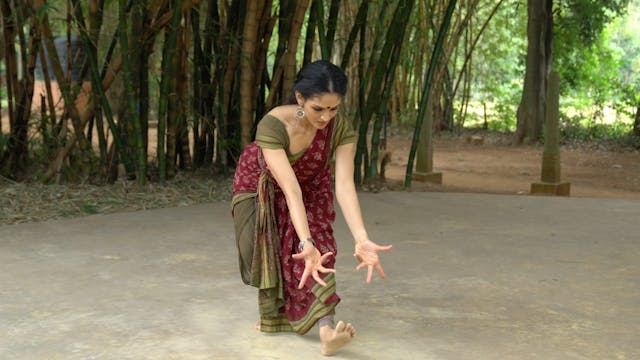Pakkadavu 4
Playlist 64: Reinforcing the bends with adavus
•
3m 33s
Pointers for Pakkadavu 4:
- Keep your shoulders down when lifting your arm.
- Make sure your arm in front of your chest doesn't cross the centre of your chest.
- Make sure you do not sit in your hip when lifting one leg. Keep the thigh pushing back on the standing leg
- do not rest your raised foot on your inner thigh when in lower speeds. Engage your muscles and maintain control.
The Pakkadavu name is derived from the movement of the entire body as opposed to a name derived from specifically the articulation of the feet. The Raadha Kalpa method practises four different types of Pakkadavu to create specificity in feet articulation. The movement of the arms are interchangeable and can be varied to an even greater number when placed in choreography.
The four types that are introduced, address with clarity four types of feet articulation in combination with most commonly used arm movements.
This progression is unique to the Raadha Kalpa method as it changes the starting and ending of each Pakkadavu by changing the use of Tattu in Araimandi or Swastikam.
Pay specific attention to the feet articulation in the Pakkadavu series. Start with the first one and then progress to the rest.
Up Next in Playlist 64: Reinforcing the bends with adavus
-
Kartharee Adavu 1
The Kartharee adavu is a movement that begins with a jump, followed by the crossing of the legs. The name could come from the hasta that is used or from the fact that the legs cross.
The bends of the bodies vary in the various types of Kartharee adavu. We usually practice this Adavu to a three ...
-
The Raadha Kalpa bends : The flat bac...
The Raadha Kalpa Method has broken down the various torso movements that are utilised in both Adavus and Karanas and found various ways to engage the right muscles to hold the aesthetic alignment while performing these bends while we are in movement. This series further breaks down the bends so o...
-
Naatadavu 3
The third Naatadavu stretches the leg out to the front. If you are unable to keep your back straight when doing this, please refer to the flexibility section and practice the tips for forward bends and try again.


